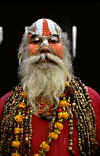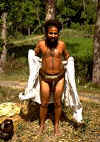|
|
||||
|
Role of
Internet In South Asian Development Technology
- a weapon to
Viewpoint Sundown Madness at Wagah Border
Heritage & Travel
Books
|
|
|
||
|
the-south-asian.com February 2001 |
||||
|
Page 3 of 4 by Dolf Hartsuiker
The Ramanandis
In the beginning of the fourteenth century, a very successful ascetic sect was founded by Ramananda: the Ramananda Sampradaya, more popularly known as the Ramanandis. Nowadays, because of its dominant position, it is regarded as a separate organization, but officially it is still part of the Shri Sampradaya, for Ramananda started his ascetic career as a member of this sect. He remained loyal to the philosophy of its founder Ramanuja, but he chose Rama and Sita as personal gods, and made devotion to them the central feature of the sect's religious practices. The epic Ramayana, with its many exemplary adventures of Rama, is the primary source of inspiration for shaping the attitude of exclusive, one-pointed devotion to Rama which is the hallmark of a Rama devotee. Rama plays an important part in contemporary Hinduism. He lives in the hearts of the common people. He rules the lives of sadhus devoted to him. For many sadhus, memorizing, analyzing, and absorbing the Ramayana is a life-time pursuit, and some become professional exegetes, reciting and interpreting the texts to the public. It is believed that just hearing the sacred words of the Ramayana is in itself liberating and will confer the grace of Rama. And in an even simpler way, continuous recitation of the name of Rama from the heart will enlighten the soul. In fact, in this Dark Age, Rama's devotees regard it as the only way to reach the Absolute. Celibacy is no doubt the most important austerity practised by sadhus. According to Yoga-metaphysics, sexual energy, the fire of passion, is the main potential source of spiritual energy. But as an aid to mental control of sexuality, physical restraint must sometimes be employed and one method is the continuous wearing of 'chastity belts'.
This austerity, like most, is usually undertaken for a minimum of twelve years. A dhoti usually, modestly, covers this wooden underwear.
|
||||
| Copyright © 2000 [the-south-asian.com]. Intellectual Property. All rights reserved. | ||||
| Home |


